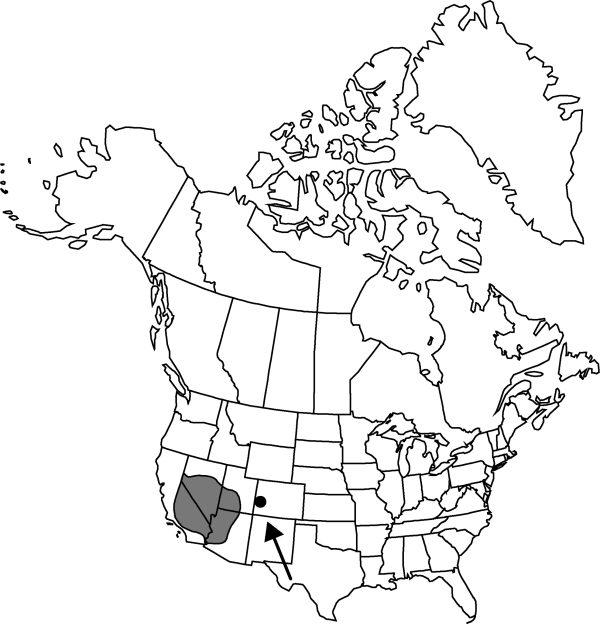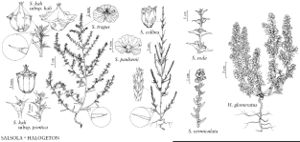Difference between revisions of "Salsola paulsenii"
Izv. Turkestansk. Otd. Imp. Russk. Geogr. Obshch. 4(5): 28. 1905.
FNA>Volume Importer |
FNA>Volume Importer |
(No difference)
| |
Revision as of 22:26, 16 December 2019
Herbs, 10–80(–100) cm, glabrous or sparsely papillose to hispid. Stems erect, rarely ascending or prostrate, profusely branched from or near base (rarely simple in underdeveloped specimens); branches straight or arcuate. Leaves alternate; blade filiform to narrowly linear, usually less than 1 mm wide, occasionally to 2 mm wide in herbarium specimens, fleshy or not, not swollen at base, apex subspinose or spinescent. Inflorescences distinctly interrupted at maturity, 1-flowered (rarely 2–3-flowered with lateral flowers mostly abortive); bracts alternate, not imbricate, strongly reflexed at maturity, base not distinctly swollen, narrowing into spinose apex. Flowers: bracteoles spreading or reflexed, distinct or connate near base, spinescent; perianth segments prominently winged (two wings usually reduced to small, almost subulate winglike appendages), apex long-acuminate or long-subulate and spinose, forming slender columnar beak distal to wings at maturity, glabrous; fruiting perianth 7–12 mm diam. 2n = 36.
Phenology: Flowering spring–summer.
Habitat: Sandy soils, disturbed natural and seminatural plant communities, semideserts, deserts, eroded slopes, sand dunes, sandy waste places
Elevation: 0-1900 m
Distribution

Ariz., Calif., Colo., Nev., Utah, se Europe, c Asia.
Discussion
Salsola paulsenii may be expected in the future also in New Mexico and Texas, as well as in some Great Plains states. It was first reported from North America by P. A. Munz (1968). Additional details of distribution and morphology of this species have been discussed by J. C. Beatley (1973c), T. C. Fuller (1986), and S. Rilke (1999).
Salsola paulsenii is weakly differentiated from S. tragus sensu stricto. Intermediate forms between them seem to be more common along margins of the natural range of the species and in secondary, synanthropic localities. According to S. Rilke (1999), the hybrids S. paulsenii × S. tragus are identical with S. ×gobicola Iljin. Forms conventionally named as “Salsola X” and “S. paulsenii lax form” with 2n = 54 (H. L. Arnold 1972; F. J. Ryan and D. R. Ayres 2000) are probably also of hybrid origin.
Reports of chromosome number 2n = 18 for Salsola paulsenii are probably erroneous and based on misinterpretation of data provided by N. L. Semiotrocheva (1983).
Selected References
None.
